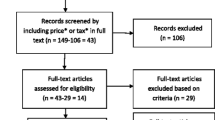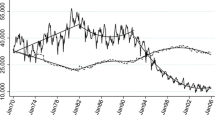Abstract
This paper estimates linear probability models for drinking prevalence and binge drinking by youth, young adults, and adults by using state-level estimates for 1999–2003 from the National Survey on Drug Use and Health. The regression models contain explanatory variables for economic influences (alcohol taxes, outlet density, income), demographics, and regulatory variables. The main results are, first, a positive relationship exists among youth and adult alcohol behaviors. Second, state-to-state variation in real beer taxes does not negatively affect youth behaviors. Third, higher outlet densities positively affect behaviors by young adults and adults, but do not affect youth. Fourth, several regulatory variables have a negative effect on drinking prevalence and bingeing by youth and young adults, including state liquor monopolies, Sunday closing laws, and 0.08 BAC laws for drunk driving. Fifth, attendance at sports events does not increase drinking prevalence or bingeing.
Similar content being viewed by others
Notes
Effective on July 1, 1998, all states had a youth BAC of 0.02 or lower. For the most part, state laws change infrequently, but the exception is the 0.08 BAC law. The 2000 Federal Transportation Appropriations Bill withheld funds from states that did not adopt a 0.08 BAC standard by 2003. During 1999–2003, 32 states had 0.08 BAC laws for adults that were in effect or which took effect.
There are several possible reasons for negative signs. First, the results are mostly negative for the younger age groups, which is consistent with shifts toward higher-priced brands. Second, advertising at sports events may reflect particular demographics (older males), with a negative spillover on younger drinkers. Third, sports advertising might lead to shifts in the timing and location of youthful drinking.
Some laws, such as Sunday closings, can be circumvented by crossing state borders. To the extent that this occurs, legal variables capture the effect of regulation on in-state alcohol sales, but fail to capture the full effects on drinking behaviors. I am indebted to a referee for emphasizing this point.
References
Center on Alcohol Marketing and Youth. (2004). Alcohol advertising on sports television, 2001 to 2003. Washington, DC: CAMY.
Chaloupka, F. J., & Wechsler, H. (1996). Binge drinking in college: The impact of price, availability and alcohol control policies. Contemporary Economic Policy, 14(4), 165–177.
Coate, D., & Grossman, M. (1988). Effects of beverage prices and legal drinking ages on youth alcohol use. Journal of Law and Economics, 31(1), 145–171.
Cook, P. J., & Moore, M. J. (2000). Alcohol. In A. J. Culyer, & J. P. Newhouse (Eds.), Handbook of health economics. vol. I (pp. 1629–1673). Amsterdam: Elsevier.
Cook, P. J., & Moore, M. J. (2001). Environment and persistence in youthful drinking patterns. In J. Gruber (Ed.), Risky Behavior Among Youths: An Economic Analysis. (pp. 375–437). Chicago: University of Chicago Press.
Dee, T. S. (1999). State alcohol policies, teen drinking and traffic fatalities. Journal of Public Economics, 72(2), 289–315.
Ellickson, P. L. et al. (2005). Does alcohol advertising promote adolescent drinking? Results from a longitudinal assessment. Addiction, 100(2), 235–246.
Grube, J. W., & Wallack, L. (1994). Television beer advertising and drinking knowledge, beliefs, and intentions among schoolchildren. American Journal of Public Health, 84(2), 254–259.
Gruenewald, P. J. (1993). Alcohol problems and control of availability: Theoretical and empirical issues. In M. E. Hilton, & G. Bloss (Eds.), Economics and the Prevention of Alcohol- Related Problems. (pp. 59–90). Washington, DC: NIAAA.
Gruenewald, P. J., Ponicki, W. R., & Holder, H. D. (1993). The relationship of outlet densities to alcohol consumption. Alcoholism: Clinical and Experimental Research, 17(1), 38–47.
Gyimah-Brempong, K. (2001). Alcohol availability and crime: Evidence from census tract data. Southern Economic Journal, 68(1), 2–21.
Jewell, R. T., & Brown, R. W. (1995). Alcohol availability and alcohol-related motor vehicle accidents. Applied Economics, 27(8), 759–765.
Mast, B. D., Benson, B. L., & Rasmussen, D. W. (1999). Beer taxation and alcohol-related traffic fatalities. Southern Economic Journal, 66(2), 214–249.
Murray, M. P. (2006). Avoiding invalid instruments and coping with weak instruments. Journal of Economic Perspectives, 20(4), 111–132.
National Academy of Sciences, Institute of Medicine. (2004). Reducing underage drinking: A collective responsibility. Washington, DC: National Academies Press.
Nelson, J. P. (1990). State monopolies and alcohol beverage consumption. Journal of Regulatory Economics, 2(1), 83–98.
Nelson, J. P. (2004a). Advertising bans, monopoly, and alcohol demand: Testing for substitution effects using state panel data. Review of Industrial Organization, 22(1), 1–25.
Nelson, J. P. (2004b). Advertising bans in the United States. In R. Whaples (Ed.). EH.Net Encyclopedia, http://www.eh.net/encyclopedia/contents/Nelson.AdBans.php.
Nelson, J. P., & Young, D. J. (2001). Do advertising bans work? An international comparison. International Journal of Advertising, 20(3), 273–296.
Nelson, T. F., & Wechsler, H. (2003). School spirits: Alcohol and collegiate sports fans. Addictive Behaviors, 28(1), 1–11.
Ornstein, S. O., & Hanssens, D. M. (1985). Alcohol control laws and the consumption of distilled spirits and beer. Journal of Consumer Research, 12(2), 200–213.
Ruhm, C. J. (1995). Economic conditions and alcohol problems. Journal of Health Economics, 14(5), 583–603.
U.S. National Institute in Alcohol Abuse and Alcoholism. (2000). 10th special report to the U.S. Congress on alcohol and health, Washington, DC: NIAAA.
U.S. National Institute on Alcohol Abuse and Alcoholism. (2005). Apparent per capita alcohol consumption: National, state, and regional trends, 1977–2003. Washington, D.C.: NIAAA.
U.S. Substance Abuse and Mental Health Services Administration, Center for Substance Abuse Prevention. (1999). Preventing problems related to alcohol availability: Environmental approaches. Washington, DC: SAMHSA.
U.S. Substance Abuse and Mental Health Services Administration. (2005). State estimates of substance use from the 2002–2003 national surveys on drug use and health—appendix: State estimation methodology. Washington, DC: SAMHSA.
Weitzman, E. R. et al. (2003). The relationship of alcohol outlet density to heavy and frequent drinking and drinking-related problems among college students at eight universities. Health and Place, 9(1), 1–6.
Young, D. J., & Likens, T. W. (2000). Alcohol regulation and auto fatalities. International Review of Law and Economics, 20(1), 107–126.
Acknowledgement
I wish to thank an anonymous referee for constructive comments on an earlier draft. Views expressed are those of the author. The usual caveats apply.
Author information
Authors and Affiliations
Corresponding author
Rights and permissions
About this article
Cite this article
Nelson, J.P. How Similar are Youth and Adult Alcohol Behaviors? Panel Results for Excise Taxes and Outlet Density. Atl Econ J 36, 89–104 (2008). https://doi.org/10.1007/s11293-007-9106-6
Received:
Accepted:
Published:
Issue Date:
DOI: https://doi.org/10.1007/s11293-007-9106-6




